Excerpts from Jim Conrad's
Naturalist Newsletter
from the July 16, 2017 Newsletter issued from Rancho Regenesis in the woods ±4kms west of Ek Balam Ruins; elevation ~40m (~130 ft), N20.876°, W88.170°; north-central Yucatán, MÉXICO
A CECROPIAS' MYSTERY CATERPILLARS
Twenty-ft-tall cecropia trees grow from the bottom of the pit adjoining the hut I live in. You can see what a cecropia looks like at www.backyardnature.net/yucatan/cecropia.htm
What's great about having cecropias in the pit is that their crowns, which usually are too high for a good look, rise to just a little higher than the hut's out-jutting porch. Therefore, the cecropias' big, umbrella-like leaves -- about the size of truck tires -- are a constant presence in my life, and a pleasing one, especially when they're glowing in brilliant tropical sunlight.
The other day I looked over and saw that something had ravaged a couple of a cecropia's big leaves, as shown below:
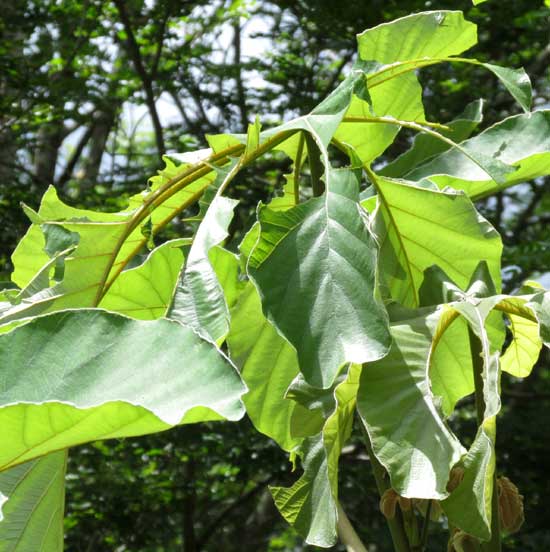
Just below those leaves, BB-size, black pellets gathered atop other ±horizontally growing leaves, seen below:
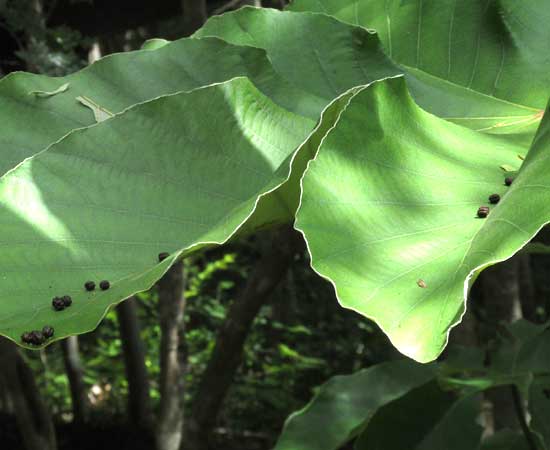
That's caterpillar poop, and it didn't take much looking to find the responsible cecropia-leaf-eating caterpillars, for there were four or five of them, and they were fairly large and black, so very conspicuous on the bottoms of the big, sunlight-charged upper leaves, as seen below:
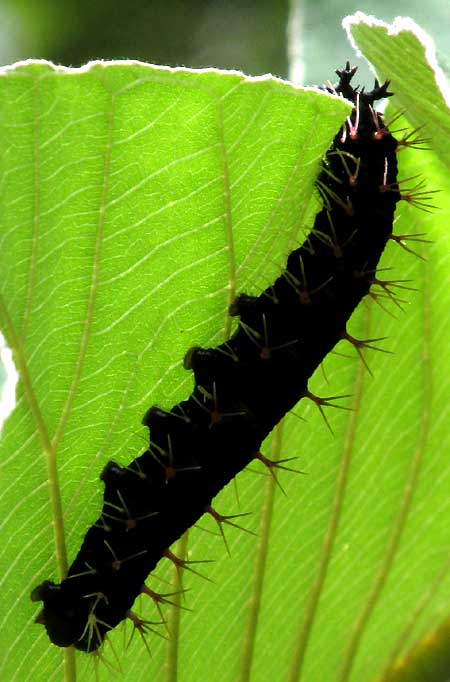
I was tickled with this discovery, because all my life I've seen huge, colorful moths in my field guides identified as Cecropia Moths, but I've never seen one. With these cecropia-leaf-eating caterpillars, maybe at least I was now seeing Cecropia Moth caterpillars. I figured that their identity should be easy to confirm, because not many caterpillar species are armed with such spectacular branched spines, and with such interesting "antlers" as seen in the above shot. Even though I was unable to get closer than about ten feet of the caterpillars (3m), with my telephoto I tried to get as many good views as possible, so volunteer identifier Bea in Ontario would have an easy time of it. A shot focusing on the head end and providing a closer view of the branched spines and "antlers" is shown below:
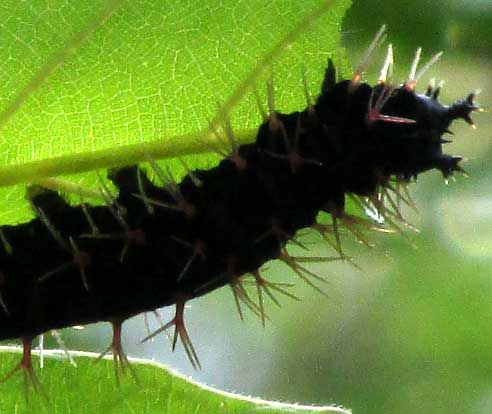
A view of the rear end appears below:
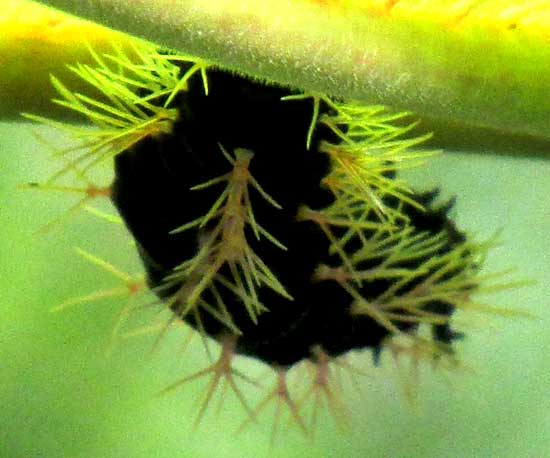
But, Bea said she didn't think they were Cecropia Moth caterpillar. When I checked the matter myself I saw that late instars of Cecropia Moth caterpillars are mostly bright green -- and mine were so large that they must have been late instars. However, anatomically they were very similar, maybe identical. Therefore, I felt sure we had something very closely related to the Cecropia Moth, which is a kind of silkmoth. I filed the above pictures and information on the Internet under the key word "silkmoth," hoping that eventually an expert would come along and help.
from the March 1, 2019 Newsletter issued from Rancho Regenesis in the woods ±4kms west of Ek Balam Ruins; elevation ~40m (~130 ft), N20.876°, W88.170°; north-central Yucatán, MÉXICO
MORE GROPING TOWARD AN IDENTIFICATION
After two years of waiting for an expert to come along, this week silkmoth expert Bill Oehlke wrote saying that the caterpillars don't look like silkmoth caterpillars, in fact, probably are butterfly caterpillars instead of moth ones.
So, back to Bea, with that new information. But, still, we just can't figure them out. Bea says that probably our caterpillars are member of the Brushfoot Butterfly Family, the Nymphalidae, which is enormous. It's like saying a plant is a grass.
Still, that's something, and when I did an image search on the keywords "Nymphalidae caterpillars cecropia," a page at the ButterfliesOfCuba.com website turned up showing caterpillars very similar to ours feeding on Cecropia leaves. That was Colobura dirce, the Mosaic butterfly, and that mostly Caribbean species has been observed in the Yucatan.
However, Bea is doubtful: "The host plant matches and the black caterpillar with yellow spines matches, but the "antlers" are not the same as yours. Yours have short black ones, while Colobura have long white ones with a black tip."
Well, it's true. Close, but no cigar, as Bea likes to say.
Anyway, now I'm filing that page under the name "aff. Colobura dirce," the "aff." for "affinity," which is an accepted formal way of saying that we know it's probably not Colobura dirce but maybe it's close, and won't you please help us figure out what it really is?...
This story is presented in the spirit of showing that in much of the world many organisms still aren't well understood, or understood at all. There's still plenty of pioneering work to be done, and often it must begin with sloppy, even embarrassing, best-guessing.